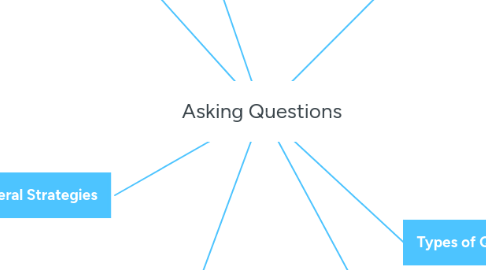
1. Wait Time
1.1. Is a crucial factor in questioning techniques
1.2. average wait time is less than 1 second, but needs to be at least 3 seconds to be more effective
1.3. The more wait time the higher student achievement, retention, number of positive responses, longer responses, decrease in interruptions, increased student-student interactions
1.4. higher cognitive questions require more wait time
1.5. more wait time allows for implementation of higher cognitive discussions
2. Feedback
2.1. A teacher's response to questions is just as important as the question asked
2.2. redirection and probing are effective when they are explicitly focused on student responses
2.3. acknowledging correct responses is necessary and effective
2.4. praise when it is used sparingly, sincerely, and credible has a positive impact on student achievement
3. General Strategies
3.1. Keep course goals in mind
3.2. aim for direct, specific questions
3.3. ask questions throughout class and ONLY ask ONE at a time
3.4. ask open-ended questions
3.5. Use Bloom Taxonomy to be sure you are asking a variety of types of questions
3.6. Reflect and Reflect on questions after you have taught
4. Strategies to Ask Great Questions
4.1. TeachThought Learning Taxonomy
4.1.1. Interdependence
4.1.1.1. how things correspond
4.1.2. Whole
4.1.2.1. see the "thing" fully within context
4.1.3. Parts
4.1.3.1. seeing individual parts of the idea
4.1.4. Abstraction
4.1.4.1. thinking about the idea creatively or in non-traditional ways
4.1.5. Self
4.1.5.1. making sense of how the thinker relates to the idea or topic
4.1.6. Function
4.1.6.1. thinking critically about how it works
4.2. Digital Taxonomy Power Verbs
4.2.1. describes cognitive actions
4.2.2. the "actions" of students is most critical component of the learning experience
4.3. Socratic Discussion
4.3.1. group learning strategy that is designed to have students interact with open-ended questions that promote critical thinking
4.3.1.1. This is done all through discussion
4.4. Paideia Seminar
4.4.1. uses Socratic discussions and involves minor student involvement to facilitate verbally an to help students communicate collaboratively
4.5. The Question Game
4.5.1. focuses on teaching creative problem-solving that helps get to the most effective solution
4.6. Bloom's Taxonomy
4.6.1. Can act as a framework or pattern to funnel content, discussions inquiry or other learning processes
4.7. Question Formulation Technique
4.7.1. a brainstorming process based around a topic
4.7.1.1. straightforward and rigorous process that helps students learn how to produce their own questions, improve their questions, and strategize how to use their questions
4.8. Universal Question Stems
4.8.1. sentence and question stems that help empower students to ask questions by giving them a head start
4.8.1.1. How does __ work?
4.8.1.2. What is most important about...?
4.8.1.3. When ____, why does ___?
5. Why Ask Questions?
5.1. to actively involve students
5.2. to increase motivation and interest
5.3. evaluate student's preparation
5.4. check on completion of work
5.5. to nuture insights
5.6. to stimulate independent learning
5.7. to assess achievement or mastery of goals and objectives
5.8. to develop critical thinking skills
5.9. to elicit correct responses
6. Types of Questions
6.1. knowledge
6.1.1. recalls data or information
6.2. comprehension
6.2.1. understand meaning
6.3. application
6.3.1. use a concept in a new situation
6.4. analysis
6.4.1. separate concepts into parts
6.4.1.1. distinguish between facts and inferences
6.5. synthesis
6.5.1. combine parts to form new meaning
6.6. evaluation
6.6.1. make judgments about the value of ideas or products
